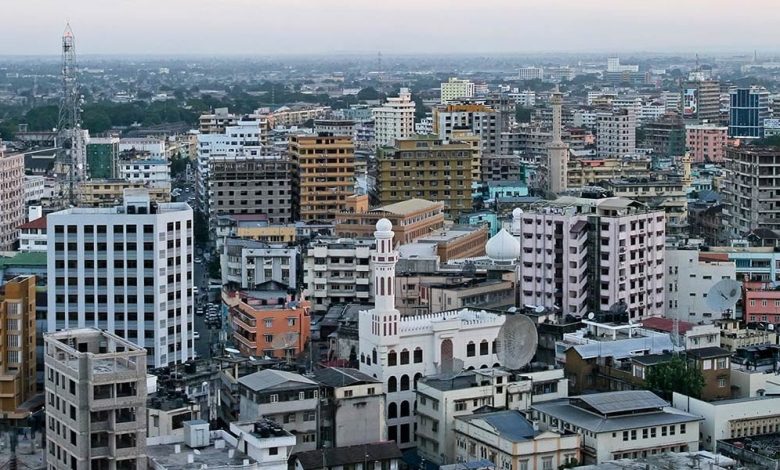Prime
South Africa power crisis: The inside story
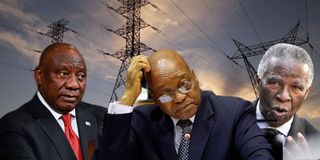
South African President Cyril Ramaphosa (left) former Presidents Jacob Zuma and Thabo Mbeki.
What you need to know:
- The country’s current challenges, both in the literal sense of electricity supply inadequacy and in terms of the present moment’s requirements, were already evident as a likely future as long ago as the mid- to late-1990s.
- Towards the end of the first post-apartheid administration under Nelson Mandela, independent energy experts began issuing warnings that, since no major power production units had been built for some years, S. Africa was on track to fall short of its capacity to match demand driven by natural population and economic growth.
- The ‘energy day zero’ was then projected as likely by the end of the first decade of the 21st century.
- However, Mandela’s ruling African National Congress (ANC) was focused on a major push to get fresh water, electricity and other key services to the many millions, both rural and increasingly, the urban poor, whose needs had, in effect, been ignored for decades.
South Africa, once Africa’s most sophisticated and developed economy, is virtually in the dark.
From the lit spot on the continent, politically, economically and technologically, Africa’s third largest economy is tottering on the brink of powerlessness.
But how did Pretoria get here? Short answer: Decades-long rot, series of blunders and leadership failures.
The country’s current challenges, both in the literal sense of electricity supply inadequacy and in terms of the present moment’s requirements, were already evident as a likely future as long ago as the mid- to late-1990s.
Towards the end of the first post-apartheid administration under Nelson Mandela, independent energy experts began issuing warnings that, since no major power production units had been built for some years, S. Africa was on track to fall short of its capacity to match demand driven by natural population and economic growth.
The ‘energy day zero’ was then projected as likely by the end of the first decade of the 21st century.
However, Mandela’s ruling African National Congress (ANC) was focused on a major push to get fresh water, electricity and other key services to the many millions, both rural and increasingly, the urban poor, whose needs had, in effect, been ignored for decades.
The apartheid system meant these people had had little in the way of what the ruling white minority took for granted, this truth pertaining either in “illegal” sprawling shantytowns rising up from undeveloped areas around major urban hubs, or for those left resourceless in so-called ‘homelands’, effectively Bantustans nominally ‘independent’ but actually client pseudo-states answerable to Pretoria.
In both instances, provision of government services was explicitly avoided.
Disadvantaged citizens
The ANC government, from 1994 through to midway through the first decade of the 2000s, was consequently focused on bringing some relief to these millions of previously disadvantaged citizens.
Since S. Africa had no pressing or immediate requirement to build more generation plants at the time, further build projects were repeatedly pushed out and, it was much later learnt, so too were critical maintenance schedules for existing, mainly coal, power stations.
S. Africa’s current electricity problems stem directly from decisions made in those years, plus during the two terms served by Mandela’s successor in office, Thabo Mbeki, further exacerbated by the two-term era of mass looting of public funds under Jacob Zuma.
In 2001, a new Free Basic Electricity policy (FBE) was introduced by national power provider Eskom, after discussions with the Department of Minerals and Energy.
The Mbeki administration’s view at the time was that “conventionally, the average poor household does not consume more than 50kWh of electricity per month”.
As a result, this amount was to be offered free of charge to any and all who qualified.
Subsidy
It proved difficult to determine a baseline of who was poor and qualifying for the subsidy, so it was decided that the subsidy should be available to all consumers, regardless of their income levels.

A man holds a sign saying that Eskom, the South African electricity public utility, is not for sale during a demonstration by members of the Congress of South African Trade Unions on February 13, 2019 in Johannesburg, South Africa.
Consequently, the amount of electricity consumed jumped well out of proportion to economic or population growth over this period, foreshortening the power shortage crisis timeline by several years.
By 2003, it was clear that S. Africa would indeed face an electricity shortage in the near future.
After some debate on how to address the issue, Eskom took the ‘easy route’, announcing “a final decision” to return three power stations, previously moth-balled and for a time potentially on sale to a French operating firm – a move prevented by the ANC’s union allies – back to service.
The move came just in time to prevent what today is the routine cutting of power, which has come to be known as ‘loadshedding’, five years earlier than it actually started.
The three retired stations, Camden, Grootvlei, and Komati, came on line just in time to meet a jump in demand, which rose precipitously in line with the country’s economic growth that leapt from 2.9 per cent in 2003 to 4.6 per cent the next year and 5.3 per cent by 2005.
With a growing economy, and a decade into post-apartheid liberation, the dividends of peace and stability were showing up in a healthy economy beginning to burgeon.
But that rapid growth also meant earlier pressure on power provision than had been envisaged a few years prior.
Annual growth
Peak demand on S. Africa’s already beginning-to-be-constrained capacity jumped from 31,928MW in 2003 to 34,195MW in 2004.
According to Enerdata, an independent energy intelligence and consulting company, with S. Africa holding a steady 4+ per cent annual growth through the first half of that decade, pressure rapidly increased on power production at a rate unexpected a decade prior.
Total energy consumption peaked in 2008 at 2.9 TOE per capita, TOE being a measure of energy usage, equivalent to that released through the burning of a tonne of crude oil.
From that point, the per capita consumption of energy dropped to 2.3 TOE by 2021 that figure though dramatically lower than a decade and half prior being still nearly four times the average energy consumption per capita in sub-Saharan Africa.
The high-point of S. Africa’s 21st century electricity consumption per capita peaked at 4,500kWh in 2007 before decreasing to 3,284kWh in 2021 – around 10 times the sub-Saharan average.
More recently, total energy consumption rebounded by seven per cent in 2021, after a nine per cent drop in 2020 due to the Covid-19 crisis.
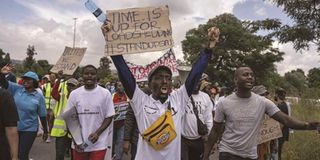
People, holding banners, stage a protest against energy crisis after electricity outages for long periods of time in Johannesburg, South Africa on February 2, 2023.
Previously, S. Africa’s consumption had increased by an average 1.3 per cent per year between 2017 and 2019.
But these figures hide the fact that consumption would have been far higher, but for loadshedding, which began — with some shock to the country and its foreign investors — in 2008.
Meeting the demand unleashed by the liberation of the country’s masses, with some major power plants in construction, the provision of new plants had been pushed onto the backburner in the late 90s and early 2000s. Kendal Power Station operates as a case in point.
This coal-fired power station lies in Mpumalanga province, which borders Mozambique, and is sited in a major coal-mining area, like several other major S. African coal-fired plants.
Built between 1982 and 1993, its first unit went online in 1988.
On completion in 1993, it became the world’s largest indirect dry-cooled power station, and represented a cutting-edge type of coal-fired power production, with each of its six units producing 686MW for a nominal total of capacity of 4,116MW.
Majuba power station
After Kendal came Majuba power station, another multi-unit dry-cooled giant plant, which first went into service in 1996 and was only completed in 2003.
Majuba, also located in the coal-rich province of Mpumalanga, provides a nominal 4,110MW.
The ‘problem of electricity’ seemed to have been solved, or had it?
That was an illusion.
In 1994, the year that apartheid was officially replaced by universal voting and human rights, electricity access was estimated by government departments and officials as between 30 and 36 per cent of the then population of 43.3 million.
Ten years later, with a population of 48.6 million, and millions more connected, what had seemed a wealth of power was suddenly in short supply.
By 2004, thanks to the ANC government’s intensive electrification drive, many millions of South Africans were enjoying the benefit.
In March 2004, some 7.8 million households – each on average having between six and seven members – had been connected, a massive jump from the three million households connected in 1990.
These facts form the foundations of the power crisis experienced with increasing intensity over the last decade and a half.
While money had been poured into connecting ever-more people, and with millions also making their own unmetered illegal connections in low-income, high-density suburbs of the country, the maintenance schedules of existing power plants were largely ignored and new plant plans were put on hold.
The result was a shortfall of power output by Eskom, then the sole electricity provider, and well before initially expected, though some forward-looking analysts had a decade earlier anticipated that by 2008 there would already be periods, especially at peak demand in the early evenings of winter months, when demand would outstrip supply.
Jacob Zuma
With the advent of the first administration of President Jacob Zuma in 2009, a simmering problem turned into the making of a full-scale disaster, just as President Cyril Ramaphosa last week declared, was now upon S. Africa, as Eskom, along with other key state entities, was stripped of talent and filled with party loyalists willing to engage in mass looting of state funds, known now as ‘state capture’.
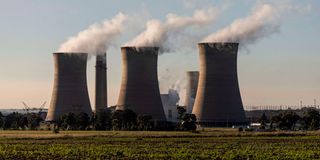
In this file photo taken on December 18, 2022 A general view of the Grootvlei Power Station, a coal-fired power plant operated by Eskom located in Grootvlei. South Africa's President Cyril Ramaphosa declared a national disaster on February 9, 2023 in a bid to fast-track efforts to tackle a record electricity shortage that has put the brakes on economic growth in Africa's most industrialised economy.
For Eskom and power provision, it has been ‘downhill’ ever since, though major efforts have been under way in the last few years under the Ramaphosa administration to put things right in Eskom.
With the latest CEO of the power utility — which despite its many problems still produces more electricity than most African states — having resigned after being poisoned at work with cyanide earlier this year, the power producer is reflecting in its governance the crisis that has come to characterise its power provision, due to a combination of people in jobs they could not do properly, and sheer thievery.
The utility has also been plagued by employees and contractors not merely ‘on the take’, but actively engaged in sabotage, largely to keep themselves employed at the taxpayers’ expense.
Belated efforts to resolve the power provision crisis were launched as a consequence of the burgeoning power issue, with two of the world’s largest coal-fired power plants, Medupi and Kusile, having been planned and partly built.
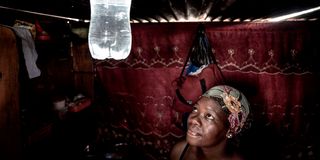
A resident looks at the light beaming from a freshly installed Amandla Elanga bottle globe inside her shack in an informal settlement in Olievenhoutbosch, Centurion, South Africa on February 6, 2023.
But these two plants, supposedly among the world’s most sophisticated multi-unit coal-burning power stations, have been plagued by poor planning, extended build programmes far beyond the planned build periods of each, and much corruption.
These plants were meant to supply around 4,800MW each, but neither has fulfilled those plans and they have turned into the world’s most expensive and second most-expensive power production plants, in terms of cost of kilowatt/hour output.
The latest update from Eskom is that these power stations will be fully completed more than a decade late, in 2023 and 2026, respectively, for Medupi and Kusile, with the latter likely never to have all six of its planned units built.
When the outages currently plaguing S. Africa started to become ‘routine’ around 2015, then-President Zuma was forced to explain the problem, which, he said, was a “legacy of apartheid” that his administration was “fixing”.
Part of the ‘fix’ was a handshake agreement between Zuma and Russian President Vladimir Putin in that same year to have Russia build a suite of six nuclear power plants, to add to the two units at Koeberg Nuclear Power Station, Africa’s only commercial nuclear plant.
But that agreement had all the hallmarks of more ‘state capture’ and a bill, in 2015 dollar terms, of more than a trillion rand, subsequent re-evaluated at up to double that amount, if construction began today, as Energy Minister Gwede Mantashe still wants to do, and which virtually all analysts say is simply unaffordable to the much-damaged S. African economy.
Also, the Russian nuclear deal was taken to the courts by anti-nuclear groups and ANC’s political opponents, the courts ruling that it was illegal, despite the Zuma administration’s repeatedly-stated determination to go ahead with it.
Electricity providers
The delays in bringing on board other electricity providers, mainly from the private sector, and due to fierce opposition from unions and others, with leftist political leanings who want no private sector involvement, has led to the crisis situation as currently defined.
Meanwhile, with outages increasing every year, there was little choice even for hardline leftists in government, and so, in 2016, the first Renewable Energy Independent Power Producer Procurement Programme (REIPPPP) was announced.
This initiative aimed at increasing electricity generation through private sector investment in solar photovoltaic and concentrated solar, onshore wind power, small hydro (less than 40MW), landfill gas, biomass, and biogas.
As of 2021, a total of 117 projects had been awarded to the private sector, with private investment totalling some $14.19 billion committed.
An additional positive to the REIPPPP, set two years ago to generate 3,922MW of renewable power, was that it would help align high-greenhouse gas emitting S. Africa to meet its commitments under the Paris Agreement as of 2018, specifically the reduction of 22.5 million tonnes of carbon dioxide (CO2) and saving 26.6 million kilolitres of water.
But even that programme has been undermined from within government.
It was pro-nuclear and pro-coal minerals and energy minister Mantashe, a former unionist who worked in the coal mining sector, who cancelled ‘at the last minute’ a concentrated solar project due for construction in the Northern Cape.
Since then, however, S. Africa’s electricity power crisis has severely worsened, despite Mantashe’s repeated comments through the last two years that S. Africa has “plenty” of power to provide, ignoring the fact that numerous ageing stations are suffering repeat outages due to failed maintenance from the mid-1990s through to around 2018.
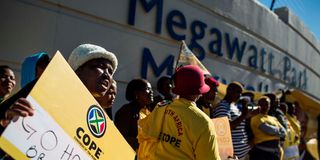
In this file photo taken on May 15, 2017 outside state entity Eskom Offices at Megawatt Park in Johannesburg, members of South African political party Congress of the People (COPE) demonstrate against the re-instatement of Brian Molefe as Eskom CEO.
Eskom, which still supplies around 90 per cent of all S. Africa’s electricity from coal-fired power plants, is now planning to spend about $6 billion on private power provision, mainly from wind and solar energy, by 2030.
The investment plan, likely a joint effort by Eskom in partnerships with private entities, is the most detailed plan yet to move away from coal and unreliable plants by taking advantage of the nation’s abundant wind and solar resources.
But Mantashe is still playing a ‘spoiler’ role, saying that a mass transition to renewables will mean an end to thousands of coal-mining and coal-fired power plant jobs.
This has meant that President Ramaphosa, and those supporting his efforts towards a sustainable and reliable power provision structure in S. Africa, have had to revert to undertaking a “just energy transition” wherein jobs retention or replacement is at the top of the energy agenda.
Renewable energy
The idea behind Just Energy Transition Partnerships (JETPs) is to support leapfrogging fossil resources to a clean renewable energy future in a number of developing states, including S. Africa.
Other countries working on JETPs are Indonesia, India, Vietnam and Senegal.
Including the decommissioning of aged power plants which are burning coal inefficiently, the cost of S. Africa’s JETP has been set at $97 billion, initially, with funding currently being sourced, and some $8.5 billion already pledged by developed nations in the International Partners Group (IPG), a grouping of rich states.
The plan – which sees nearly $100 million being spent over the next five years – was formally handed over by President Ramaphosa to the IPG at COP27.
The rich countries also intend to provide additional funding beyond that already committed.
But moving S. Africa's economy entirely onto a greener energy provision basis will cost vastly more in the longer term, with some analysts estimating at least $250 billion over the next three decades.
The first phase of the JETP will cost $5.4 billion and will focus mainly on quick-build renewable plants, solar and wind, but also involving pump and other storage as well as limited hydro, but with no significant geothermal sources, which are more difficult in S. Africa than elsewhere.
In all, around 37 million people in the JETP countries so far involved in the programme lack access to energy and many live in remote areas, making modular wind and solar installations attractive solutions, especially as the cost per KWh for both has fallen sharply, with solar now cheaper than coal.
President Ramaphosa has set up commissions and advisory panels to assist him and his administration with climate change and power crisis planning, but Eskom’s plans, which are in line with the President’s outlook, are still being publicly opposed by Mantashe.
The intensity of the situation on the ground, where businesses and homes are doing without electricity twice or more a day for two or more hours at a time, and causing ongoing severe impacts on the country’s GDP, likely wiping out, at current levels, around 2 per cent of growth in 2023, are such that even hardliners like Mantashe have been forced to acknowledge the reality of the power emergency.
In light of which, and despite internal resistance, S. Africa is now set on a course of little coal use and dispersed, resilient power provision from mainly renewable resources.
The first phase of this programme, which spans 2022 to 2023, sees 246MW of photovoltaic solar power being built at the Arnot, Duvha, Lethabo, Majuba and Tutuka coal-fired power plants.
The idea is to use existing facilities to reduce the cost and loss of jobs as the country moves increasingly towards renewables.
Coal-fired power
A further 100MW of solar-generation capacity is be constructed at Komati, the first of the ageing and much-troubled coal-fired power plants slated to close, and 19.5MW of solar power at the site of the Sere wind-power plant in the Western Cape province.
The second phase, which runs from 2023 to 2025, sees the construction of a 750MW concentrated solar power plant at Olyvenhoutsdrift in the Northern Cape – essentially the same plant that Mantashe previously ruled out on the eve of its construction – and 600MW of photovoltaic power added at Sere.
Eskom wants also to build 300MW of wind power at Kleinzee on S. Africa’s northwest coast and 200MW of wind power at Aberdeen in the Eastern Cape province.
A further 250MW of renewable energy generation capacity is in line to be built on the sites of decommissioned coal-fired power plants.
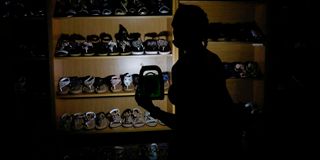
In this file photo taken on February 16, 2022 A woman uses a rechargeable LED lantern to illuminate a shoe rack while shopping at the Sinnoville Centre after its electricity supply was cut off by the City of Tshwane municipality for allegedly having a bill of 16 Million South African Rands, in Pretoria.
The third phase of the ambitious plan envisages the building of a further 2,950MW of solar photovoltaic capacity between 2025 and 2030, as well as another 3,100MW of wind power.
The main problem around these plans is finding affordable funding, with Eskom’s government-assured debt already sky-high at about $22.4 billion, mainly from an overrun in the cost of construction of the Medupi and Kusile coal-fired plants.
But the Ramaphosa administration is confident that it can raise the necessary borrowings at affordable rates, especially as not doing so will cost the country, ultimately, far more in the long run.
Last week, ahead of Ramaphosa’s ‘state of disaster’ announcement spurred by the persistent electricity shortage, it was announced that, rather than exporting electricity to less developed neighbouring states like Zimbabwe, as once was the case, S. Africa would be “acquiring” around 3,000MW (3GW) to help bridge its persistent shortfall of output of about double that figure.
Aside from the reversed fortunes involved, the significance of this move to help curb economy-ravaging outages plaguing S. Africans and their businesses, lies in the fact that it still will not end the planned ‘loadshedding’, which has become such a bane of existence for the great majority.
Social unrest
While willing to forgive many of the ANC’s failings in 29 years at the helm of the country, the warning from National Treasury of imminent social unrest arising from ongoing outages – which could jeopardise SA’s security, and would certainly further undermine its attractiveness to vitally-needed foreign investors – is a reflection of mounting citizens’ anger that power outages have become an intolerable burden set to last for at least the “next two to three years”.
Ramaphosa’s announcement, and comments from some of his ministers, that a focused drive to rectify repeat failures in ageing coal-fired power plants – failures also occurring in some of the newer plants and sometimes caused by deliberate sabotage – could see routine outages phased out by year’s end, are seen by industry experts as aimed at placating the rising tide of public anger, rather than being ‘realistic’.’
The simple truth is that Eskom’s problems – indeed, the wider issues of persistent poverty, unemployment figures that are among the highest in the world, associated criminality of all types and arising socio-political instability – and which began even before the ANC had stopped fighting against apartheid, are not going to magically be waved away.
The reality is that S. Africa’s put-upon citizens have a long way to go yet before they see the end of a crisis made much worse by the same governing party that now says it is intent on solving problems that it could and should have averted.
Tomorrow:Changing fortunes of Joburg, the ‘New York of Africa’.




